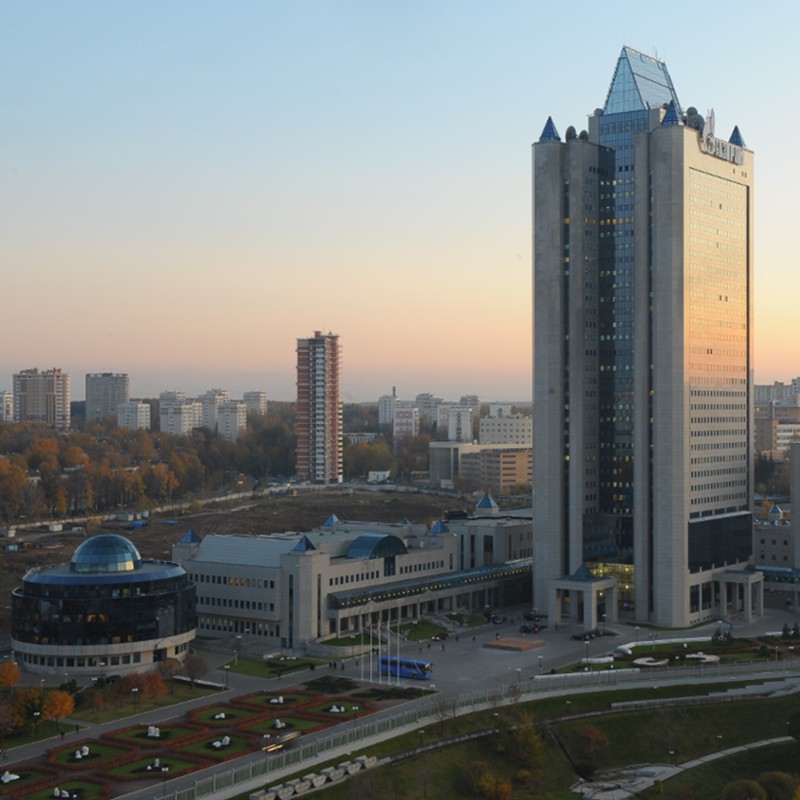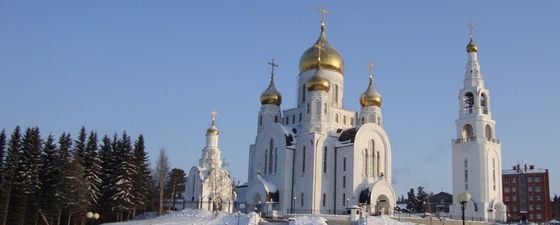Khanty Mansiysk lies seemingly in the middle of nowhere, the capital of a hilly region the size of France called the Khanty Mansi Autonomous Okrug, in Siberia. Human habitation in the area dates back 4,000 years, as evidenced by well-preserved Stone and Bronze Age monuments. It is built on seven hills, and is dominated by the river Irtysh and its tributaries. The city experiences a subarctic climate, with extremes of temperature as low as -49°C, causing the rivers and lakes to freeze for most of the year in long, severe winters. It stands far away from the large metropolitan cities, being 2,500 km from Moscow, and even further from St. Petersburg. Even the nearest train station is four hours drive away from Khanty Mansiysk.
And yet, this small city is fast becoming a modern center of Russian business, sport and tourism. Its population has more than doubled since 1989 to nearly 90,000 people, and with this growth the city has changed tremendously. It has become an alpine centre of importance as an annual site for Biathlon World Cup competitions, a winter sport that combines cross-country skiing and rifle shooting. It also held the 2010 Chess Olympiads, the largest international chess team tournament in the world. Events such as these bring in tens of thousands of tourists, who flock to the city from all around the world.
An Oil City
 Gazprom is one of many Russian oil and gas companies with flamboyant new headquarters in Khanty Mansiysk. (Source: Gazprom)The source of this economic growth in a small Siberian city far away from larger populations is, of course, entirely due to the discovery of oil in the region. The greater Khanty Mansi Autonomous Okrug region contains around 70% of Russia’s developed oil fields, about 450 in total, including Samotlor, which is the largest oil field in Russia and the sixth largest in the world. Gas was first found in the region in 1953 and oil began to be produced in 1960, and the region now contributes over 50% of total Russian oil production.
Gazprom is one of many Russian oil and gas companies with flamboyant new headquarters in Khanty Mansiysk. (Source: Gazprom)The source of this economic growth in a small Siberian city far away from larger populations is, of course, entirely due to the discovery of oil in the region. The greater Khanty Mansi Autonomous Okrug region contains around 70% of Russia’s developed oil fields, about 450 in total, including Samotlor, which is the largest oil field in Russia and the sixth largest in the world. Gas was first found in the region in 1953 and oil began to be produced in 1960, and the region now contributes over 50% of total Russian oil production.
Khanty Mansiysk is home to the ostentatious headquarters of the country’s main oil giants, including Rosneft, Lukoil and Gazprom-Neft. Enormous drilling towers protrude from the birch forests, while gas flares blaze over the treetops, and roads and pipelines cut through the landscape. Around 90% of the city’s economic production is directly dependent on the oil industry, and everything thrives as a result of it. Even the art gallery exists only because of oil, with small plaques next to the paintings purchased from Moscow and St. Petersburg identifying sponsors such as Rosneft and Lukoil.
As well as the annual sporting events, the city also contains multiple places of interest for tourists, including the glittering gold domes of the Church of Christ’s resurrection. It also holds museums on art, such as the artist Gennady Raishev’s gallery; the Geology, Oil and Gas Museum, which traces the history of Western Siberian oil and gas development; and an open air Archeopark, which has bronze sculptures of Pleistocene animals like mammoths and woolly rhino. The park is located at the foot of a hill known as Samarovsky, which is composed of Eocene sediments, usually buried at greater depth in this area. Its origin is a matter of controversy, but it is possibly a larger erratic, deposited here at the edge of an icesheet during the Pleistocene.
A happy oil boom town of Khanty Mansiysk (Source: RussiaNowTV)
A Heavy Cost?
Many would argue that this flourishing city and the oil and gas it provides for the rest of Russia and beyond comes at a heavy cost through the destruction of the environment and damage to the indigenous people who lived on it for thousands of years. The people native to the region are the Khanty and the Mansi, who survive off the land through fishing, hunting and reindeer herding. They traditionally migrate around the area with the seasons, from winter settlements to seasonal hunting grounds. However, since the growth of the oil industry in the region, the livelihoods of these peoples have been affected. The land is owned by the state, and therefore vast areas of forest used by the Khanty and other tribes for building settlements and canoes have been cut down or burnt in order to make way for the construction of roads, housing for workers and pipelines. Endless Siberian forests that used to provide Khanty families with all they needed have shrunk into small reservations that are officially called ‘Areas of Traditional Nature Use’.
As well as this, oil spills are affecting the environment. Dilapidated Soviet-era infrastructure has meant that, as of January 2010, the Ecology Department of Khanty Mansiysk Autonomous Okrug registered 4,979 accidents, including 2,417 oil pipeline failures. The total pollutant mass in the environment amounted to 5781.4 tons. The region’s biggest river, the Ob, alone releases 125,000 tons of crude oil into the Arctic Ocean annually, according to Greenpeace. As a result of this oil in the natural environment, the rivers and soil can no longer so successfully supply the fish, vegetation and grazing grounds the indigenous tribes need to survive.





